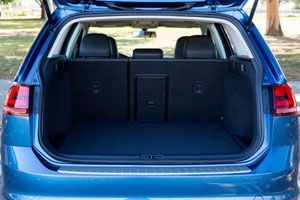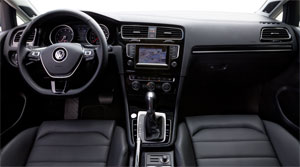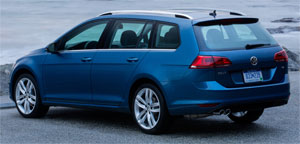2015 Volkswagen Golf SportWagen
By now you’ve heard all the Volkswagen turbo diesel fiasco. Residual values, VW stock prices, and brand image have all taken a beating over recent months. But, what’s been lost in all of the hubub is that there’s a new Golf Sportwagon. And, despite the diesel disaster, the Sportwagon deserves it’s time in the spotlight.
For those fans that were upset over the demise of the Jetta SportWagen, we have great news. It’s hasn’t really gone away, it’s just been re-designed, and renamed, as the 2015 Volkswagen Golf SportWagen.
And that means it is now using VW’s fantastic MQB architecture, and the benefits of that are almost endless. It weighs less, is more economical, and despite shifting from Jetta to Golf nameplates, it even has about the same amount of space inside.
We’re certainly okay with the expansion of the Golf lineup, as it has always been one of our favorite cars. But what we’re not fine with of course, is the recent news regarding Volkswagen’s deceptive practices when it came to getting their TDI diesel’s emission’s certified.
 We spent time in a urea-injected TDI equipped SportWagen back in the summer, before all of this came to light. And averaged 37.0 miles-per-gallon, which is actually better than the Combined Government Fuel Economy Rating of 35, to go along with 31-City, and 42-Highway.
We spent time in a urea-injected TDI equipped SportWagen back in the summer, before all of this came to light. And averaged 37.0 miles-per-gallon, which is actually better than the Combined Government Fuel Economy Rating of 35, to go along with 31-City, and 42-Highway.
We’ve always been huge fans of the TDI and have always gotten exceptional fuel economy results, but perhaps in retrospect we should have known it was almost too good to be true. It’s not a total disaster however, as independent testing has concluded that with a software fix, fuel economy might decline as little as 5%.
Ultimately it will be the consumers that will decide the TDI’s fate when and if Volkswagen gets things sorted out.
We also drove a TSI-equipped gasoline fueled SportWagen; and here we also bested expectations, averaging 33.3 miles-per-gallon of Regular. The official Combined is only 29, with 25-City and 35-Highway. Its legitimate Energy Impact Score comes in at 11.4 barrels of oil consumed yearly with CO2 emissions of 5.0-tons.
The 1.8-liter I4 in the TSI is rated at 170-horsepower and 199 lb-ft. of torque and is available with either a 5-speed manual or 6-speed automatic transmission.
 Compared with a Golf 5-door, there’s 12.0-inches of additional length, yet it rides on a wheelbase that’s actually been shortened by a bit. Overall length, however, is almost exactly the same as the departing Jetta SportWagen.
Compared with a Golf 5-door, there’s 12.0-inches of additional length, yet it rides on a wheelbase that’s actually been shortened by a bit. Overall length, however, is almost exactly the same as the departing Jetta SportWagen.
As far as design, there’s only so much you can do with the two-box wagon shape, the Golf’s take is without a doubt more purposeful and less bloated than the Jetta’s.
The forward portion of the interior doesn’t depart at all from the simple Golf theme, and we’re just fine with that. Material quality is good, and seat comfort better than expected.
Cargo capacity in the hold is down slightly to 30.4 cubic-ft., but after dropping the rear seat backs, the space expands to 66.5 cubic-ft. And that’s much more space than all of the rapidly growing subcompact crossovers have to offer.
And it’s much more fun to drive as well. Here at the track, it was as capable as we hoped, and handles way better than a car this big should. The extra 100-pounds or so of weight over the hatchback did nothing to compromise handling here; or ride quality on the way back to the office.
0-60 times were quicker in the TSI, as you would expect, though not by much. 8.7 TSI, verses 9.0-flat for the TDI. Both are a little sluggish off the line, while they wait for their turbos to spin up the boost.
 So naturally, the TSI completes the 1/4-mile more quickly as well; taking 16.2-seconds to trip the lights at 88 miles-per-hour. Stops from 60 averaged a good 125-feet. Brake feel was great and fade was minimal.
So naturally, the TSI completes the 1/4-mile more quickly as well; taking 16.2-seconds to trip the lights at 88 miles-per-hour. Stops from 60 averaged a good 125-feet. Brake feel was great and fade was minimal.
With all of the pricy cars we test these days, at $22,215; the Golf SportWagen packs about everything you could want in a tidy, highly affordable package. 2016 editions tack on only a couple hundred dollars more. For the time being, the TDI is not available pending recertification. Expect about a three grand premium when it returns.
So, while VW’s deception has certainly tempered our enthusiasm for the 2015 Volkswagen Golf SportWagen, and it’s in fact difficult for us to recommend any Volkswagen at the current time, the SportWagen is still a good idea. But even good ideas need the proper timing to be great ones.
Specifications
- Engine: 1.8 liter I4
- Horsepower: 170
- Torque: 199 lb-ft.
- 0-60 mph: 8.7 seconds
- 1/4 mile: 16.2 seconds @ 88 mph
- EPA: 25 mpg city/ 35 mpg highway
- Energy Impact: 11.4 barrels of oil/yr
- CO2 Emissions: 5.0 tons/yr
2024 Polestar 2
More Range And More Power For The Polestar 2
Volvo is well on their way to making the transition to an all-electric brand, but their sister-brand Polestar is already there. Now, we’ve spent lots of time in their all-wheel drive, five-door Polestar 2, having tested it in 2021, and a year later when a two-wheel drive version arrived. But, EV updates are coming quickly. So, let us be your guide for all that’s new with the Polestar 2.
While we are driving more EVs than ever, we’ve also been spending a lot of time recently circling back to ones we’ve previously tested. As in this new era of electrified vehicles, significant updates are arriving quickly, with R&D investments increasing and retrofitting them easier than ever. This is often done through software updates that can even be accomplished over the air. For 2024, the Polestar 2 has indeed gotten some software updates, but some physical ones as well.
Clearly aimed directly at Tesla’s Model 3 when it arrived; the Polestar 2’s build quality was vastly better, but range definitely came up short. So, addressing that was priority No. 1; and for ’24 the Polestar can travel up to 20% farther than before while consuming 9% less energy, and when it comes time to charge it back up, it can do that 34% faster too.
Range in the Single Motor version increases from a max of 270 to 320 miles thanks to a larger 82-kWh battery pack, and that solitary motor now powers the rear wheels, not the front wheels. It’s also bigger, coming in at 220 kW compared to the previous 170 kW front-wheel drive version, going from 231 to 299 horsepower.
Dual Motors keep the same 78-kWh battery, but still sees a boost from 260 to 276 miles and takes advantage of the larger rear motor for a new combined 310-kW output with 421 horsepower. Our test car has the added Performance Pack, which uses an additional 35 kW to deliver 455 horsepower and 546 lb-ft of torque, though max range drops to just 247 miles.
The new battery in rear-drive 2s will also charge faster, now accepting up to 205 kW for an 80% charge in 20 minutes; max for dual-motors stays at 155 kW, which puts an 80% charge at 34 minutes. Using 32 kWh of electricity per 100 miles, the Dual Motor earns a good efficiency rating.
The [Polestar] 2 has always been one of the most enjoyable EVs to drive, even more so now with that additional power coming from the rear motor.
Unfortunately, extremely cold temperatures kept us from seeing that increased range, as we were only on pace for about 194 miles in our test.
The 2 has always been one of the most enjoyable EVs to drive, even more so now with that additional power coming from the rear motor. And especially when equipped with the Performance Pack as it not only includes more power, but adds 20-inch forged wheels, upgraded brakes, and adjustable Ohlins Dual Flow Valve performance dampers. It greatly improves handling prowess without affecting ride quality, and is easily worth the $5,500 charge if you at all enjoy driving.
Even on a 20-degree track day there was plenty of grip through our handling course. No understeer or oversteer, and lots of feedback through the wheel. There was a nice, strong launch off the line that properly planted us firmly in the seat, and rocketed us to 60 in 4.5 seconds. Power delivery stayed pretty intense up until about 80 mph when there was a definite tapering off. Still, it was a 13.4-second quarter-mile at 102 mph; smooth, quiet, and stable the whole way.
When this car debuted, its Google-based infotainment setup was a novelty, but since then, more and more manufacturers are just “Googling it” so it doesn’t seem out of place at all. The wireless phone charger is easy to access, and there’s a great Harmon/Kardon sound system and panoramic sunroof to enhance the in-cabin experience. Exteriors have also been enhanced with a smooth grille insert and new wheel choices.
Hatchback practicality means 14.3 cu-ft of easy to access cargo space with split-folding seatbacks for longer items and expanding the space to 38.7 cu-ft. Plus, there’s even a sizeable storage bin up front under the hood.
Single Motor Polestar 2 pricing now starts at $51,300, with Dual Motors starting at $56,700; topping out at $64,400.
For a car manufacturer that hasn’t even been around for a decade yet, Polestar has kept itself busy, totally transforming their latest model in just a few years, making the 2024 Polestar 2 even more appealing. They are certainly off to a good start, and with a host of Polestars just over the horizon, including some all-important utility vehicles, this star will be shining even brighter.
Specifications
As Tested
- Motor Setup: Dual Motor
- Horsepower: 455
- 0-60 mph: 4.5 seconds
- EPA Range: 247 miles
- Efficiency : 32 kWh / 100 miles
- Battery Size: 78-kWh
- Torque: 546 lb-ft
- 1/4 Mile: 13.4 seconds at 102 mph
- MW Test Loop: ~ 194 miles
- Peak Charging Rate: 155 kW











































